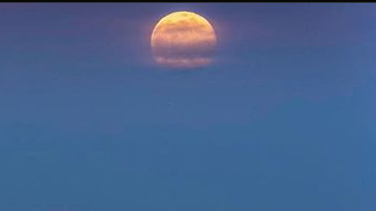“A Super Blue Moon is a visual gift to stargazers, offering a unique opportunity to witness the moon in its full glory, and it’s an event that won’t occur again for many years, making it even more special.” – National Geographic
“This Super Blue Moon will light up the night sky, and it’s a perfect occasion to reconnect with the natural world and marvel at the wonders above us.” – Jane Houston Jones, Former NASA Astronomer
August’s night skies are set to dazzle as the first supermoon of 2024, also a blue moon, graces the heavens from Sunday through Wednesday. This celestial event, the first of four consecutive supermoons this year, promises a stunning sight for astronomy enthusiasts.
The full moon will reach its peak brightness on Monday, August 28, at 2:26 p.m. EDT, but it will appear full for three days, starting from Sunday morning and continuing through early Wednesday, according to NASA. This prolonged visibility offers a rare opportunity to enjoy the supermoon in all its glory.
August’s full moon, a rare blue moon and supermoon, will look full starting today. Here’s what time it will peak and where you should look.#Bluemoon #Supermoon
Read more: https://t.co/c3mep7hGWs pic.twitter.com/my5d76oOoN— MSN (@MSN) August 17, 2024
Supermoons occur when the moon’s orbit brings it closest to Earth at the same time as a full moon. During this month’s supermoon peak, the moon will be about 225,288 miles from Earth, making it appear larger and brighter than a typical full moon—about 16% brighter, to be precise. To the naked eye, the difference is akin to comparing the size of a quarter to a nickel.
This August’s supermoon is also a blue moon, though those hoping to see a blue-tinted moon will be disappointed. The term “blue moon” has nothing to do with color. Instead, it refers to the third full moon in a season that has four full moons or the second full moon in a month that contains two full moons. This particular blue moon fits the former definition.
August’s full moon carries several traditional names, the most prominent being the Sturgeon Moon, a reference to the giant lake sturgeon that were easily caught during this time of the summer in the Great Lakes and Lake Champlain. Other names include the Red Moon, Corn Moon, Barley Moon, and Dog Moon, reflecting various cultural associations with this time of year.
Following this supermoon, the next three will occur in September, October, and November. The September full moon, known as the Harvest Moon, will peak on Tuesday, September 17, while October’s Hunter’s Moon will reach its peak on Thursday, October 17. November’s Beaver Moon will be the final supermoon of the year, peaking on Friday, November 15. Notably, the full moons in September and October are expected to be the closest of the year, virtually tied for proximity to Earth.
The Supermoon Blue Moon is coming. Here’s what to expect https://t.co/GVb4CyAqDK
— HK (@HKgolfgoon) August 17, 2024
For those interested in catching a glimpse of this supermoon, no special equipment is necessary. The moon can be observed with the naked eye, though binoculars or a telescope can enhance the experience, allowing for a closer look at the moon’s features as it shines brighter than usual in the night sky.
Quotes
- “The August 2024 Super Blue Moon is a rare celestial event that combines two special occurrences—a Blue Moon, which is the second full moon in a calendar month, and a Supermoon, when the moon is at its closest point to Earth in its orbit. It’s a stunning reminder of the beauty and wonder of our universe.” – Astronomy Magazine
- “This Super Blue Moon is not just a spectacular sight but also a symbolic event, reminding us of the cycles of nature and the passage of time. It’s a moment to pause and appreciate the grandeur of the cosmos.” – Neil deGrasse Tyson, Astrophysicist
- “Supermoons always capture the imagination because they appear larger and brighter in the sky, but when combined with the rarity of a Blue Moon, it becomes an even more magical experience.” – Bill Nye, Science Educator
Key Points:
i. August’s supermoon blue moon, the first of 2024’s four consecutive supermoons, will be visible from Sunday through Wednesday, reaching peak illumination on Monday at 2:26 p.m. EDT.
ii. A supermoon occurs when the moon’s orbit brings it closest to Earth during a full moon, making it appear larger and brighter than usual.
iii. Despite being called a “blue moon,” it won’t appear blue; the term refers to either the third full moon in a season with four full moons or the second full moon in a month.
iv. This month’s full moon is also known as the Sturgeon Moon, with other names including the Red Moon, Corn Moon, and Barley Moon.
v. The following supermoons will occur in September, October, and November, with the closest full moons of the year expected in September and October.
TL Holcomb – Reprinted with permission of Whatfinger News

